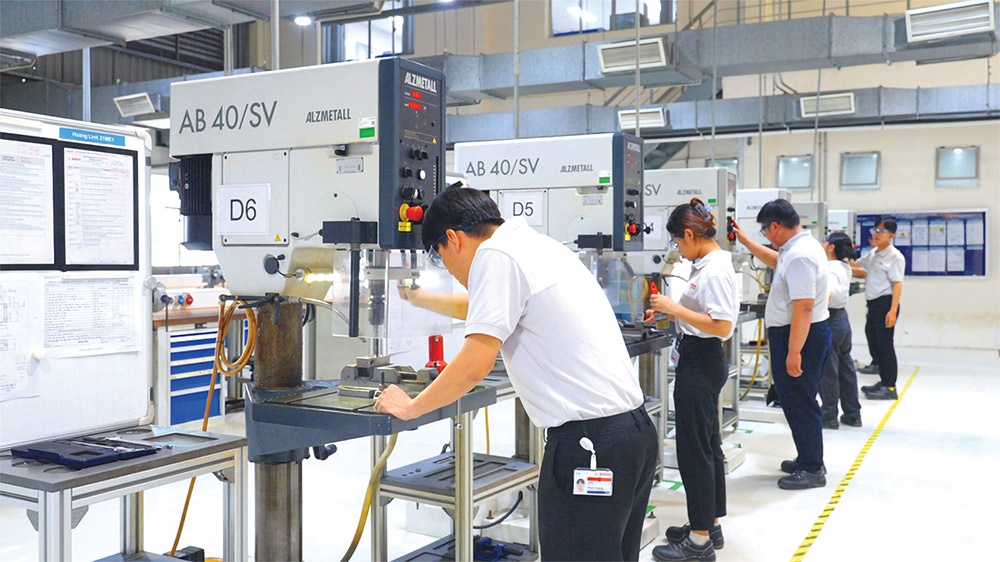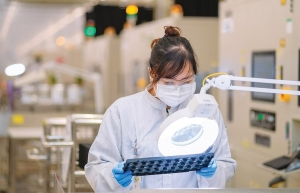Future bright for innovative FDI schemes
The Foreign Investment Agency (FIA) under the Ministry of Planning and Investment revealed last week that over a dozen projects on semiconductors, research and development centres, innovation centres, and training of high-quality human resources totalling tens of billions of US dollars will soon be granted investment certificates, and are being negotiated in various localities.
 |
| The most notable groups exploring investment in Vietnam involve high-tech processes, Photo: Le Toan |
The latest report from the FIA, released in September, reflected that foreign direct investment (FDI) continues to increase strongly in both newly registered and implemented capital. The report highlighted, “The results of FDI attraction and disbursement affirm the attractiveness, competitiveness, position, and potential of the Vietnamese market in the eyes of international investors, as well as the promotion of the increasing FDI trends over the past several months.”
More than $20.5 billion in FDI has been reported in Vietnam up to the end of August, an on-year increase of 7 per cent, while disbursed FDI has risen by 8 per cent on-year to about $14.15 billion.
The northern province of Bac Ninh has become the leading locality in wooing FDI, with a total registered investment capital of nearly $3.47 billion, accounting for 16.9 per cent of Vietnam’s total FDI, almost triple figure over last year. Ranked second in FDI attraction is the northeastern province of Quang Ninh with nearly $1.78 billion, holding 8.7 per cent of the total registered FDI, and more than 2.3 times higher than the same period.
Ho Chi Minh City ranked third with a total registered investment capital of more than $1.76 billion, responsible for nearly 8.6 per cent, followed by Ba Ria-Vung Tau, Hanoi, and Haiphong.
Van Duc Phu from the Northern Investment Promotion Centre said that the increasing FDI inflows are contributed by Vietnam’s economic diplomacy. “High-level meetings have opened up many great opportunities for Vietnam in mobilising FDI, especially in semiconductors and AI, which are currently the focus of global investors,” Phu said.
“In particular, many companies, especially large technology corporations, are currently exploring conditions for new investments in Vietnam. The most notable are corporations that master modern technologies, and produce high intellectual-content and added-value products,” he added.
Many of the world’s giants in the semiconductor and AI industries, such as Intel, Google, Nvidia, Samsung, Hyosung, Amkor, Hana Micron, and Synopsys, have all invested in Vietnam.
Among many large projects, Amkor has already raised investment by over $1 billion, years earlier than the plan set forth. Other investors in the high-tech sector are speeding up activity in Vietnam. Following three factories with investment of $500 million, Meiko Electronic has been building a new factory in the northern province of Hoa Binh at a cost of $200 million, and planing to increase to $500 million.
In addition to electronics and semiconductors, data centres are also expected to become hot in Vietnam in the near future. A super-large data centre is already in the works to be developed by Google in Vietnam, with an investment of about $300-650 million. Alibaba is also considering building a data centre in Vietnam.
Meanwhile, at the upcoming Innovate Vietnam 2024 and fifth anniversary of the Vietnam Innovation Centre on October 1-2, Meta’s global relations chair Nick Clegg, along with leaders of Qualcomm and Nvidia, will be present in Hanoi to discuss innovation in Vietnam.
“These are important factors for Vietnam to improve the quality of inputs and create changes in growth quality, enhance the economy to a new level,” Deputy Minister of Planning and Investment Nguyen Thi Bich Ngoc said at a press conference in early September.
According to Nguyen Mai, chairman of the Vietnam Association of Foreign-Invested Enterprises, in addition to political stability, Vietnam’s proactive policies and improved FDI attraction are being highly appreciated by foreign investors.
“Our strategy of attracting FDI in areas such as semiconductors is in the right direction,” Mai stated. “However, in the context of intense competition and global minimum taxes, it’s challenging to adapt to the global investment environment.”
The government should direct localities to improve in accordance with international practices as well as find measures and incentives to meet investor needs for large projects, Mai added.
 | Vietnam sustaining growth amidst shifting FDI trends Trade ties between the US and emerging market economies in the Asia-Pacific region are shifting from efforts to diversify supply chains out of China through “friendshoring” or “nearshoring”. Against this backdrop, Vietnam is among the Asia-Pacific markets relatively well-placed to gain from such shifts. |
 | UOB forecasts Vietnam's economic growth to continue, boosted by trade and FDI Vietnam's economy is expected to maintain strong growth throughout 2024, supported by rising trade activity and increasing foreign direct investment, while favourable demographics and solid macroeconomic fundamentals underpin its long-term prospects in ASEAN, according to UOB. |
 | FDI results in localities above expectations Many localities have reported a surge in foreign direct investment this year, and it looks as though they may surpass set targets. |
 | Vietnam’s foreign investment landscape in 2024 and beyond Foreign investment inflows into Vietnam have remained exceptionally strong in 2024, and there are clear signs that it will continue to pour into the country for years to come. |
What the stars mean:
★ Poor ★ ★ Promising ★★★ Good ★★★★ Very good ★★★★★ Exceptional
 Tag:
Tag:
Related Contents
Latest News
More News
- Government moves to establish International Financial Centre (December 21, 2025 | 21:00)
- Vietnam's IFC to target global investment flows (December 21, 2025 | 18:00)
- Two national hospitals expand capacity with new facilities (December 20, 2025 | 09:00)
- Ha Tinh breaks ground on major Vingroup industrial and energy projects (December 19, 2025 | 18:24)
- EVN launches major power infrastructure projects nationwide (December 19, 2025 | 18:17)
- VAL inaugurates second production line to meet domestic animal feed demand (December 19, 2025 | 16:37)
- Sun Group pioneers urban tram system in Phu Quoc (December 19, 2025 | 15:00)
- Seven major projects launched to drive Hanoi’s next growth phase (December 19, 2025 | 14:00)
- Securing capital and efficiency for Vietnam’s 2026-2030 growth ambitions (December 17, 2025 | 10:00)
- Vietnam bucking trend in the global M&A landscape (December 16, 2025 | 14:20)






















 Mobile Version
Mobile Version